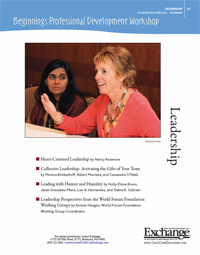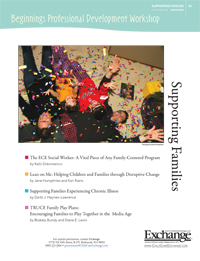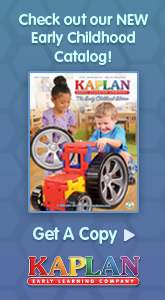ExchangeEveryDay Past Issues
 << Previous Issue
| View Past Issues | | Next Issue >>
<< Previous Issue
| View Past Issues | | Next Issue >> -Eugene Ionesco
In his article, "The Gift of Talent," in the Beginnings Professional Development Workshop curriculum unit Talent and Passion, David Elkind talks about the relative importance of socialization and individualization, and uses the Tiger Mom phenomenon as an example of socialization:
"It is really frightening that we are now trying to model our educational system after that of Asian countries. Our schools are increasingly emphasizing rote learning, fixed curriculum, and the curtailing of teachers’ freedom to innovate. Many schools have done away with recess to devote more time to academics. Late afternoon Cram Schools, which flourish in Asia, have become increasingly popular here....
"In trying to emulate the Chinese, we may be taking away the freedom young people have to play, daydream, and to learn things in a style that is best for them. Such activities are not a waste of time, but are essential to the stimulation of original thought. It is not surprising that truly talented individuals like Bill Gates and the late Steve Jobs, both dropped out of the university because it was too confining.
"Certainly we want our children to be socialized, to learn the tool skills and acquire the knowledge and values that will make them good citizens. But we also want them to be able, as famed Swiss psychologist Jean Piaget wrote, 'to think for themselves and not to accept the first idea that comes to them.' Individualization and socialization are complementary and not in conflict with one another.... The goal of education and parenting should be to have children who are original, but who use their originality for the common good."
$4 Each For 24 Hours Only!
Enter Code "beginnings4" when prompted.
Exchange Press has 120 16-page Beginnings Workshop units, each addressing a specific early childhood curriculum topic in-depth. For two days only, all Beginnings Workshop units are on sale for $4 each!
View and Purchase Titles
(Offer applies to PDF only. Sale ends 05/04/2016 11:59 pm PDT)






Comments (7)
Displaying 5 of 7 Comments [ View all ]VINCI Education
boston, MA, United States
I have the privilege to experience both East and West styles of education so do my children. I have to say that each style has its strengths and weaknesses. Asian style focuses more on basics. Very few adults I met in North America can pull out the result for a quarter of 60% without a calculator. Typical Asians can. It may not seem that important but all I want to say is that there is a huge lack of basic skill teaching in our current education system. But Asian style lacks system and reasoning learning, as well as creative innovation. Ask a Chinese 5 year old and he can easily get you 2 digit addition or subtraction. But if you ask the same kid to identify a 2 step reasoniing problem he'd get all lost.
Montessori with a Reggio twist is what the City of Shanghai is implementing for all their public preschools. Don't forget, 80% of Shanghai's 3year old are enrolled in a quality public preschool. By the time we get there in the states. That will already solve a lot of achievement issues.
Aldea Montessori
Phoenix, Arizona, United States
It is interesting to note that as we try to emulate the Chinese learning model, the Chinese are moving away from that very model. During the past five years, two of the largest provinces of China have converted their public schools to the Montessori method. The Association Montessori Internationale has trained hundreds of teachers and teacher trainers so that more and more schools can be fully Montessori. The Chinese have learned that rote learning does not produce the next Bill Gates or Jeff Bezos. It pushes the factory model of learning where everyone is the same to even higher degrees. It is sad to see that the United States is following in the footsteps of a program that has already proved it does not work.
Until adults stop trying to determine what children must learn and give the teachers and students the flexibility to be creative in learning, the problems will not be solved.
Spirit Child Yoga & ECE
Aurora, ON, Canada
I agree that we do need to be careful of too much emulation of some of the Asian schools. I recall visiting a preschool in Japan where every child was making the exact same cut and paste Father's Day card as every other child. The focus was on the cutting the shapes and pasting them in the correct sequence to make a picture of "their father". There was no value on individual creativity. In China, I saw hundreds of preschoolers doing all the same exercises at the same time under the flag. Then again I saw a child hanging on to the back of a motor cylcle darting through traffic on the way home from school with dad. I saw Japanese children serving hot soup to their class mates and carrying (shudder!) glass milk bottles to each other.
Somewhere here, we do need to learn from each other in creating excellent early learning environments. We in North America need to make sure that our children can memorizes some things. If they do it in a fun and interactive way great, but they must learn their timetables. Learning to count by two's and five's is something my own children did not learn in school. Chinese five year-olds memorize hundreds of characters. Japanese children learn three sets of writing plus English. Our children need only learn 26 letters and 10 numerals. I realize fully that knowing the name of a letter is not the same as knowing the sounds it can make. I understand that recognizing 3 isn't the same as understanding the concept of three, but these basics are still needed. They work hand-in-hand with the creative parts of ourselves.
Balance!
United States
Steve Job and Bill Gate quited in 80's when Asians were not a thought to compare in many ways.
Some facts to show the problems of early eduction in U.S:
30% of first year students of an famous IVY league college claims that they are not ready for college education especially of economics and engineering.
High tech positions in my technological companies have to hire immigrants because they can't find suitable candidates among citizen applicants.
Many mathematics related graduate schools/departments full of foreign students, where citizen students are minors.
The faculty pool in the universities that help to produce the high competitive work force in industries and in science are immigrants and now are retiring, and the pool of replacement is shrinking.
scores is not perfect to reflect a person's fll-spectrum performance. Nothing can do that alone. But it is at leas a minimal bar to tell a person' s basic capability of learning in academics and the capability of adaption to environments. BASIC.
The newest education research tells that western education teach students that learning is fun, but later students find that learning is not actually fun for many classes and then some of them give up for real fun outside of school. But Asian style is to tell learning is not fun at the beginning, and students some how are forced to learn at beginning, but later once they grow up and accept the truth of benefits of learning they change attitude are self motivated to work hard.
The philosophy of supporting creation or original thoughts are not against rigid requirements of curriculum. They can work in a synergistic way. It is not creative to think improving academic performance is killing the creation.
Education style is not necessary to choose between A and B. There is middle way, why not? because of Arrogance.
United States
Are we ignoring culture when discussing "Tiger Mom" tendencies?
Post a Comment